Introduction
The discharge of radioactive effluents [1] from nuclear power plants and their radiological impact on the environment are significant concerns in radioactive waste management, radiation protection, and environmental impact assessment owing to the rapid development of nuclear power generation worldwide [2, 3]. Radioactive fission products are produced in fuel during power generation in nuclear power plants. Neutron activation products are produced in structural and cladding materials. These fission products may be released from the small amount of fuel in the broken cladding into the reactor coolant, causing radioactive contamination. This results in coolant effluents containing artificial radionuclides, such as 90Sr, 137Cs, and 60Co [4], all of which undergo β decay to produce β rays. 90Sr and its daughter 90Y are pure β decay nuclides and are considered to be highly dangerous radionuclides and carcinogens. Once 90Sr is absorbed by the human body, it is stored in bones and cannot be eliminated. Therefore, it is crucial to locate and quantify 90Sr activity to assess the effects of radiation on nuclear power plant workers. On March 18, 2023, the Japanese government announced that equipment for discharging contaminated water from Fukushima into the sea was in operation [5]. It is expected that over a period of 30 years, more than one million tonnes of nuclear waste will be discharged into the sea. Radioactive substances accumulate in marine food chains over time and pose potential health risks to humans[6-8]. Measuring β-emitting radionuclides in nuclear fuel and radioactive effluents is essential for understanding the activity of the fuel and the radioactive content of the waste. This facilitates the management and disposal of radioactive waste. These spectra exhibit a continuous distribution of particle energies
Research on spectrum analysis methods for the hybrid β-energy spectrum has been conducted domestically and internationally for many years to simplify the process. In 2016, Gui-Feng et al. proposed a method for analyzing the spectrum by establishing a linear relationship between the fitting parameters and quenching index based on the asymmetric dual sigmoid function fitting of the 90Sr/90Y liquid scintillation logarithmic energy spectrum at different quenching levels [14]. In 2022, Castells et al. developed the DECLAB software for analyzing the liquid scintillation β-logarithmic energy spectrum. They constructed a partial least squares (PLS) model for the standard liquid scintillation β-logarithmic energy spectrum and considered classical calibration models, such as constant efficiency and quenching curves, in a liquid scintillation spectrometer [15]. The aforementioned studies partially resolved the issue of separating samples for measurement. However, they encounter problems such as poor fitting and low measurement efficiency. To overcome these issues, in this study, we propose a new algorithm, the Fourier fitting interpolation method, for resolving hybrid β-energy spectra. This method is based on the spectral analysis advantages of the β-logarithmic energy spectrum and fitting ability of the Fourier series function. It realizes fast and accurate resolution of the hybrid β-energy spectrum data and provides a new method for more efficient β-nuclide measurements.
Material and Methods
Material
Figure 1 shows 90Sr/90Y sample source used in the activity error analysis, which was prepared by the Guangdong Radiation Environment Monitoring Technology Center. The method for preparing 90Sr/90Y sample source was as follows: 10 mL of 90Sr/90Y standard equilibrium solution with a reference activity of 37.157 Bq/mL was used. Subsequently, strontium [16] and yttrium [17] carriers were added, and oxalic acid was added to precipitate strontium oxalate and yttrium oxalate. The resulting 90Sr/90Y sample source had a 100% recovery rate. The β sample source had an initial activity of 371.44 Bq and was used for the activity error analysis experiments.
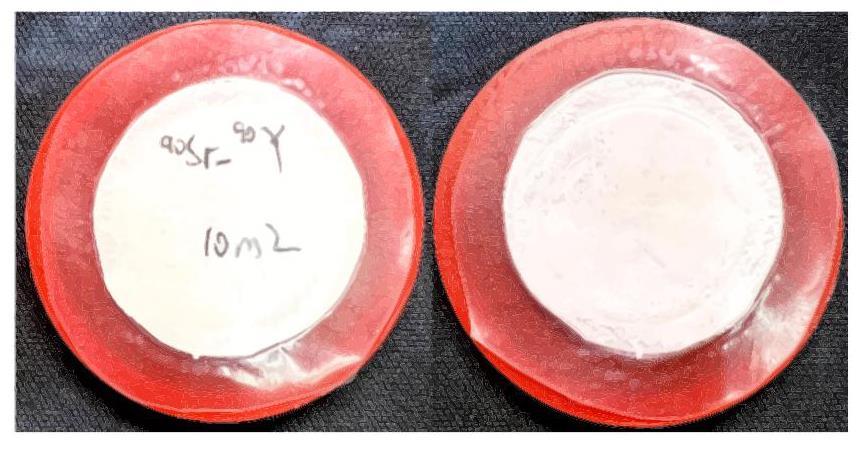
β-Logarithmic Energy Spectrum System
In contrast to the shapes of α and γ decay spectra [18], the β decay spectrum is continuously distributed. Figure 2 shows the β-linear energy spectrum [19]. Given that βnuclides emit βparticles with a continuously distributed energy range from zero to the maximum energy Em, some βmeasurement systems use a logarithmic processing function to handle the βenergy spectra. Figure 3 illustrates this logarithmic conversion process.
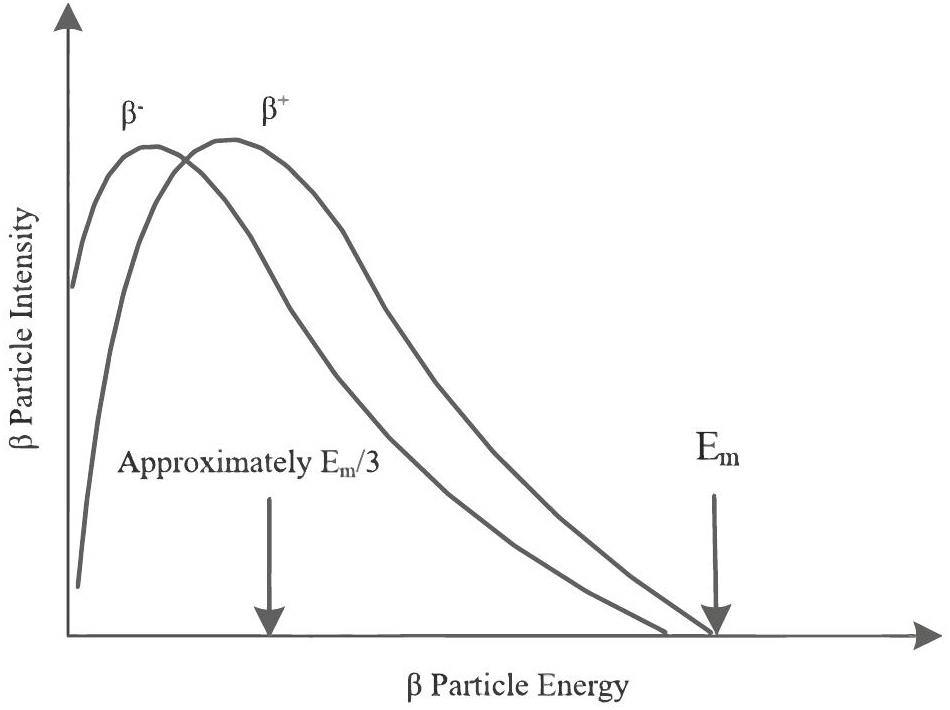
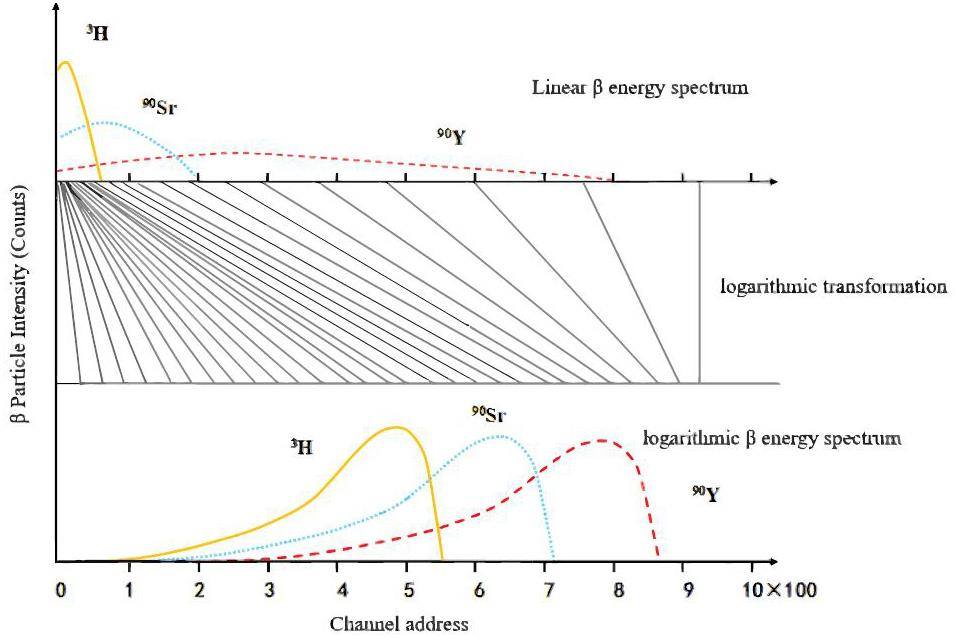
β-Logarithmic energy spectroscopy offers several advantages over linear energy spectroscopy. First, it can significantly enhance the energy resolution in the low-energy range without significantly reducing that in the high-energy range. This solves the problems of inaccuracy and incompleteness of the linear energy spectrum at the low-energy end of the measurement. When analyzing low-activity decay events, the statistical error for each energy channel remains almost constant across the entire energy range of the measurement, owing to the flat background spectral line of the β-logarithmic energy spectrum. Therefore, liquid scintillation spectrometry [20] logarithmic processing of βenergy spectrum is more suitable for conducting energy-spectral analyses of two or more βnuclides.
Fourier Series Function Fitting Model
Curve fitting [21] is a widely used technique in data analysis, statistics, and computer vision, among other fields. Its primary objective is to gain a better understanding of the data, make predictions, and infer the underlying laws by constructing mathematical expressions that match data trends. Common curve-fitting methods include the least-squares, kernel, and spline methods [22, 23].
Least squares [24] is a widely adopted curve-fitting technique. The core concept involves minimizing the sum of the squares of the residuals between the model predictions and actual observations by adjusting the model parameters. This achieves optimal fitting. In practice, the least-squares method can be used to determine the coefficients of a model. This ensures that the fitted curve closely follows the distribution trend of the real data, thereby improving the accuracy and reliability of the model predictions. However, the least squares method is highly sensitive to outliers. Therefore, when fitting the hybrid β-energy spectrum, any outliers or noise in the data can significantly affect the fitting results, causing the fitting curve to deviate from the real data trend [25]. Equation 1 shows the least-squares method for a model with n data points: Here, yi represents the actual data point value and f(xi) represents the value fitted by the model.
Equation 4 shows the triangular Fourier series [30], which includes the sine and cosine functions. This series is frequently used in spectral analysis to treat unknown bounded nonperiodic functions as periodic functions in a specific region.
• Step 1: Establish the Fourier series fitting function model with order N of 0 to 50, choose the Bisquare robust nonlinear least squares method of LM optimization algorithm to complete the function fitting of order 0 to 50 (robust preprocessing reduces the influence of outliers in the fitted data on the fitting results), and calculate a, ci, and
• Step 2: Calculate the sum of squares of the differences between all the fitted data and original data of order N from 0 to 50 using Eq. 7, denoted as
• Step 3: Using the Eq. 8 penalty function PFN, calculate the corresponding order N that minimizes the penalty function PFN from order 0 to 50 as shown in Fig. 4 as the better fitting order NG.
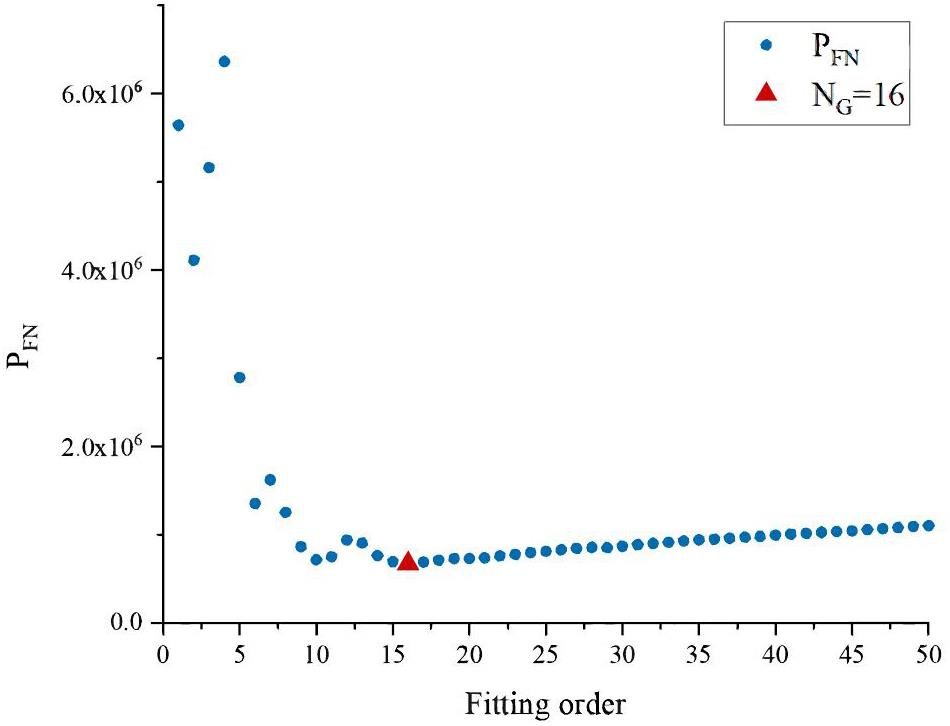
The penalty function PFN is used to measure the quality of the fit, by which it is possible to assess the effectiveness of the fit using different orders and select the fit order that minimizes the penalty function as the better-fit order NG.
If the optimal fitting order NG does not yield satisfactory results, we can further consider the coefficient of determination R2 (Eq. (10)) corresponding to the fitting function around NG. By evaluating the distribution of residual values in the ‘effective low-energy window’ for
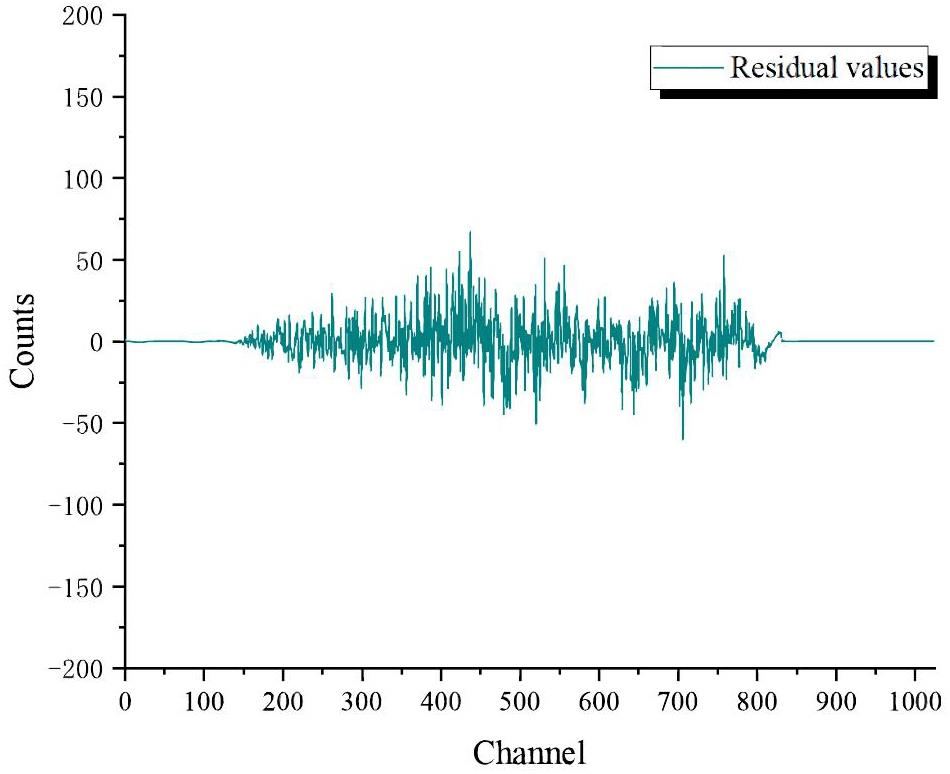
Once the order of the optimal fitting function Nb is determined, the hybrid logarithmic fitting energy spectrum can be plotted using (fF(i)) points
Cubic Spline Interpolation
The cubic spline interpolation function [33] ‘connects’ the 'effective low-energy window' and the ‘effective high-energy window’ of the hybrid β-logarithmic fitted energy spectrum to produce a smooth continuous curve, i.e., the highest Em nuclide β-logarithmic fitting energy spectrum. It has the advantages of a simple formula, fast calculation speed, and good stability and is designed to ensure calculation efficiency by making the β-energy spectrum coherent, smooth, and retains the details of the original data in the entire energy range, which provides a more reliable and accurate basis for the subsequent analysis and interpretation of the data [34].
For y=f(x) in a given interval [a, b] with the given p nodes,
1. On each subinterval
2. S(x) is 2nd order derivable in [a, b] interval and the derivative function is continuous, i.e.,
3. The function S(xk) is equal to the function value yk (k=1, 2, ..., n).
From condition (1), S(x) in each
1. Given the values of the first order derivatives at the two endpoints:
Algorithmic Process
This algorithm has five main modules: logarithmic conversion, curve fitting, cubic spline interpolation processing, difference processing, and activity calculation. The specific process is as follows.
1. Use the logarithmic processing function provided by the liquid scintillation spectrometer to convert the β-linear energy spectrum into a logarithmic energy spectrum;
2. Curve fitting of the hybrid logarithmic energy spectrum using an ‘optimized’ Fourier series function model with ‘effective high energy windows’ and ‘effective low energy windows’ for the highest Em nuclides in the current hybrid β-logarithmic fitted energy spectrum;
3. Select the ‘effective high-energy window’ and ‘effective low-energy window’ in the hybrid β log-fit energy spectrum and use cubic spline interpolation to obtain the log-fit energy spectrum of the β nuclide with the highest Em;
4. Differencing the current hybrid log-fit energy spectrum with the log-fit energy spectrum of the β-nuclide with the highest Em yields a new hybrid log-fit energy spectrum comprising the other β-nuclides with lower Em. Substituting this into Step 3 and iterating according to the previous procedure, the logarithmic energy spectrum of each nuclide can be resolved;
5. After resolving the hybrid logarithmic energy spectrum, an activity calculation is performed for each of the resolved logarithmic fitted energy spectra. The activity calculation formula is shown in Equation 22. Here, A denotes the source activity, C denotes the total counts of the energy spectrum, t denotes measurement time, ε denotes detection efficiency, and R denotes sample recovery rate.
Results and Discussion
The experimental environment involves a liquid scintillation spectrometer and GEANT4 simulation detector model. Two types of experiments were conducted to verify the feasibility and validity of the Fourier fitting interpolation method. First, 14C, 90Sr, and 90Y energy spectra obtained using the Fourier fitting interpolation method were compared with the original simulated 14C, 90Sr, and 90Y energy spectra of GEANT4 to verify the consistency between the measured and simulated energy spectra. Second, the Fourier fitting interpolation method and Asym2Sig method are used to analyze the liquid scintillation test data and GEANT4 simulation data of the 90Sr/90Y sample source, respectively, to evaluate the advantages and limitations of the Fourier fitting interpolation method.
GEANT4 Simulation of 14C90Sr90Y Energy Spectrum Analysis
The GEANT4 simulated 14C/90Sr/90Y hybrid logarithmic fitted energy spectrum shown in Fig. 6 is fitted using an ‘optimized’ Fourier series function model. Considering that Em = 0.156 MeV for 14C, 0.546 MeV for 90Sr, and 2.284 MeV for 90Y, the part of the channel group at the high-energy end of the energy interval from 0.546 MeV to 2.2839 MeV (750 to 870 channel group) and the ‘presence’ section after the zero channel are all counted. Part of the low-energy end of the channel group (channels 0–140), where the counts are all zero, can be considered to be contributed by 90Y with the highest Em in the mixing spectrum alone. Therefore, the 750 to 870 channel groups and the 0 to 140 channel groups of the fitted spectra are selected as the ‘effective high-energy window’ and ‘effective low-energy window’ corresponding to the highest Em nuclide 90Y and then they are ‘connected’ using cubic spline interpolation. Then, using the cubic spline interpolation process, we ‘connect’ them to obtain a smooth spectrum, i.e., the β-logarithmic fitted spectrum corresponding to the 90Y nuclide.
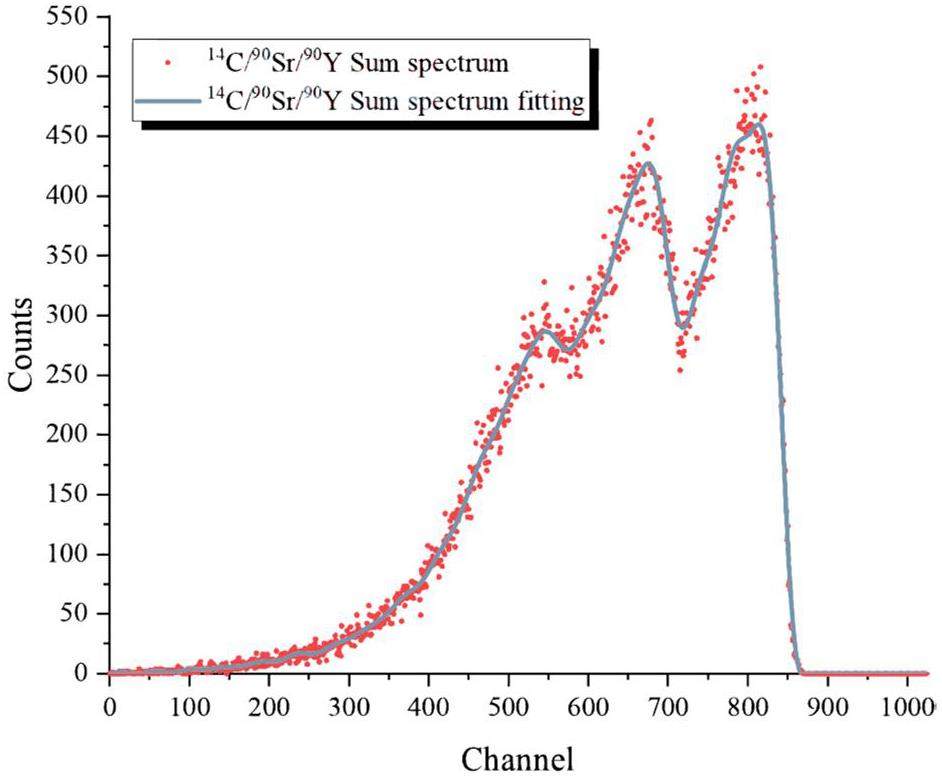
In the order of Em from largest to smallest (90Y → 90Sr → 14C), the 14C/90Sr/90Y hybrid log-fit energy spectrum is initially processed by difference with the log-fit energy spectrum of 90Y to obtain the 14C/90Sr hybrid log-fit energy spectrum. Subsequently, 14C/90Sr hybrid log-fit energy spectrum is processed using cubic spline interpolation to obtain a log-fit energy spectrum corresponding to the 90Sr nuclide. Next, the 14C/90Sr hybrid log-fit energy spectrum is processed based on the difference from the log-fit energy spectrum of 90Sr to obtain the 14C log-fit energy spectrum. Finally, 14C/90Sr/90Y log-fit energy spectrum and the resolved 14C, 90Sr, and 90Y log-fit energy spectra were obtained as shown in Fig. 7.
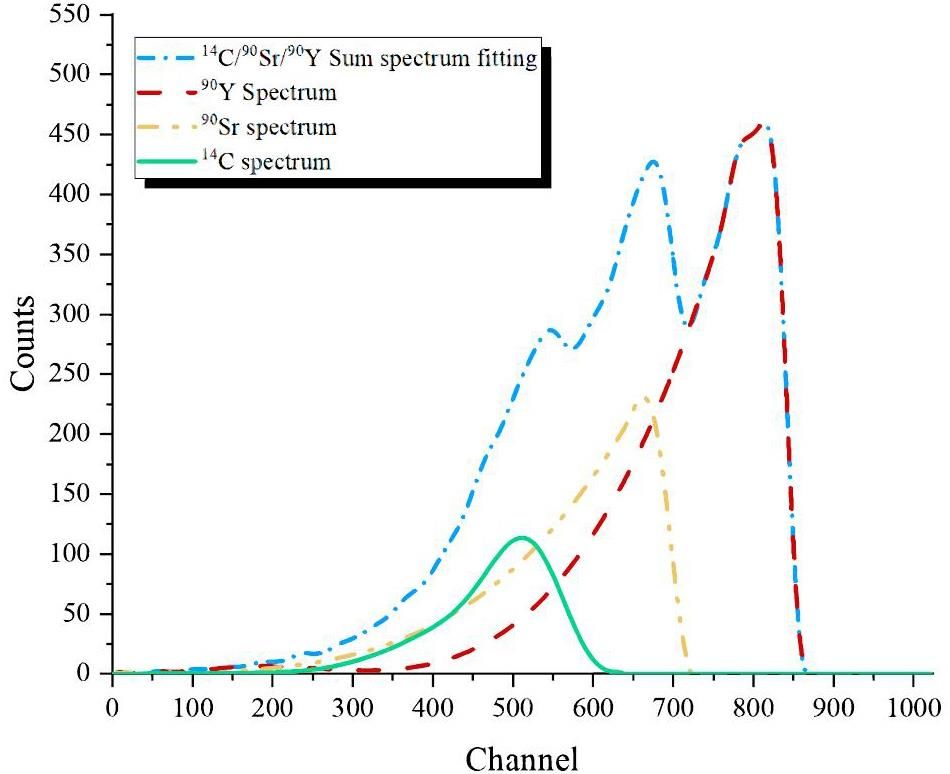
Based on the presentation in Fig. 8, we compared 14C, 90Sr, and 90Y energy spectra, which is obtained by using the Fourier fitting interpolation method with the original GEANT4 simulated energy spectra. The results showed good agreement between the two methods, verifying the feasibility and validity of the Fourier fitting interpolation method in the experimental setting of a liquid scintillation spectrometer. This shows that the energy spectra obtained by the Fourier fitting interpolation method are consistent with the actual simulation data and can accurately reflect the distribution of the particle energy spectra under experimental conditions. This result provides strong support for the use of Fourier fitting interpolation for liquid scintillation spectrometer data analysis and provides a reliable method and basis for the further development of liquid scintillation spectrometers in nuclear physics experiments and applications.
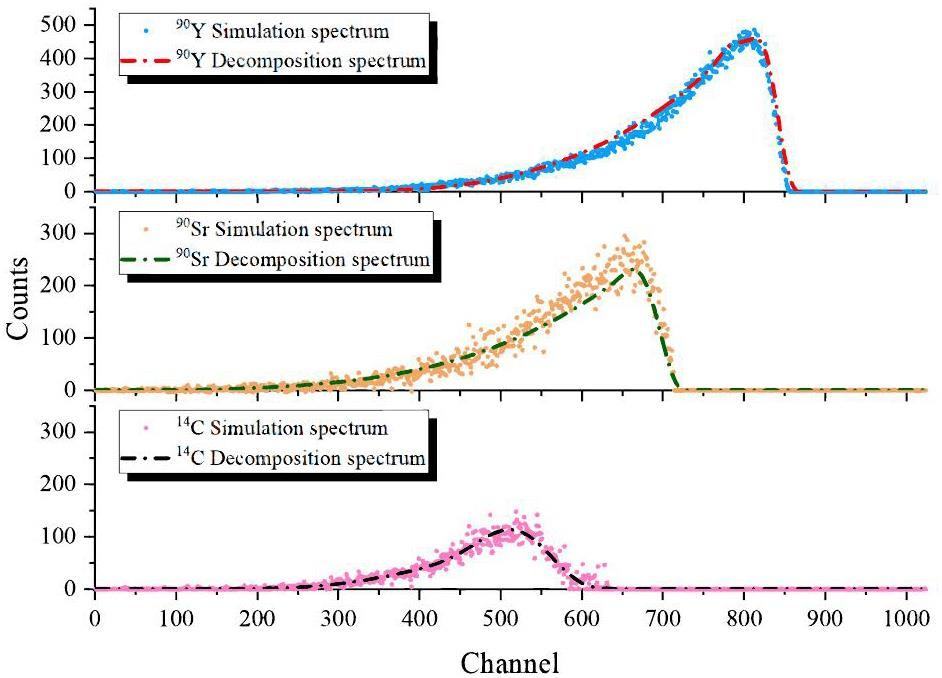
Activity Error Analysis
Fourier Fitting Interpolation Method
To measure the 90Sr/90Y sample source, the liquid scintillation spectrometer used was the Quantulus1220 ultra-low background liquid scintillation spectrometer from Perkin Elmer, USA. The detection efficiencies for 3H and 14C were 25% and 68%, respectively. The background counting rate (relative to the 3H energy region) was 0.067 s-1. The distance between the source and scintillator incident window was set to 1 mm, and the measurement time was 7200 s. The Fourier-fitting interpolation method was used to analyze the energy spectrum of the 90Sr/90Y sample source. The results show that the measured detection efficiency of the liquid scintillation spectrometer for the 90Sr/90Y sample source was 25.721%. The full-spectrum detection efficiency of GEANT4 simulation was 27.24%. Given that the initial activity of the 90Sr/90Y sample source is 371.44 Bq and the half-life of 90Y is 64 h, it can be concluded that 90Sr and 90Y in the sample are in a long-term equilibrium state. Therefore, the activities of 90Sr and 90Y are equal, indicating that the actual activity of 90Y is 185.72 Bq.
According to the process described above, the 35th-order ‘optimized’ Fourier series function is used to fit the measured energy spectrum of 90Sr/90Y and channel group of 340 to 500 is selected as the ‘effective high-energy window’ corresponding to 90Y. By analyzing the Geant4 simulation results and liquid scintillation energy spectrum data, the corresponding channel of 23.8 keV in the logarithmic energy spectrum of 90Sr/90Y was still in the channel group with a count of zero, and a channel group of 1 to 10 was selected as the ‘effective low-energy window’ of 90Y. Using cubic spline interpolation to ‘connect’ the ‘effective high-energy window’ and the ‘effective low-energy window’ to get a smooth spectrum, i.e., the 90Y energy spectrum. The fitted 90Sr/90Y energy spectrum is subtracted from 90Y energy spectrum to obtain the 90Sr energy spectrum. The results of the Fourier-fitting interpolation method for the 90Sr/90Y sample source are shown in Fig. 9.
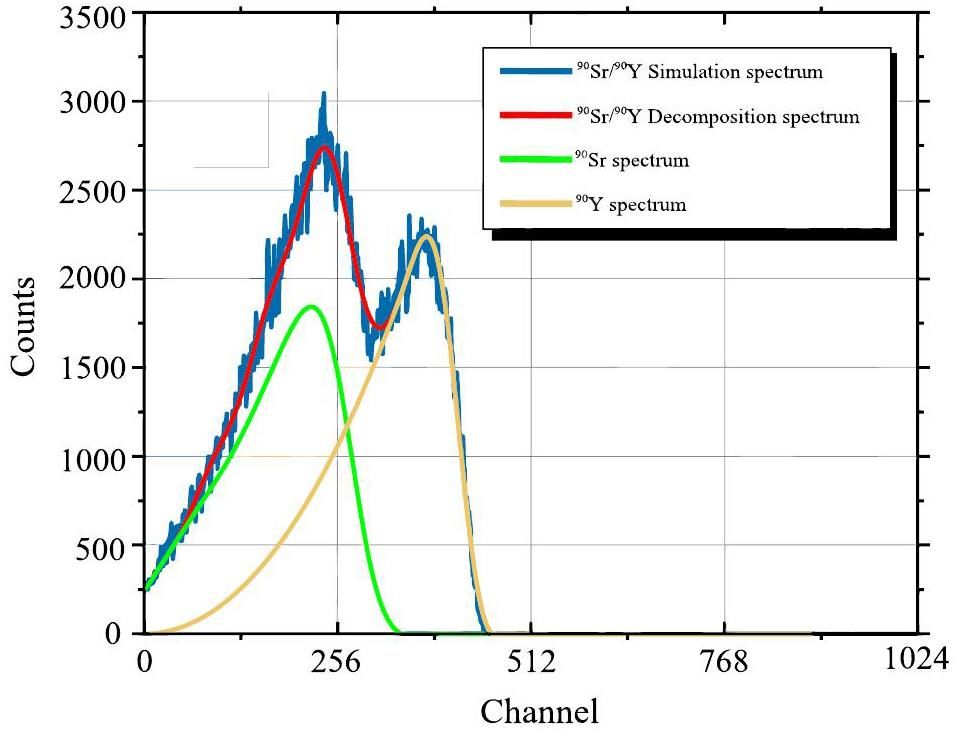
By analyzing the results of the Fourier fitting interpolation method, we obtain the following conclusions: the average count rate per minute of 90Y is 3173.803 CPM, i.e., the activity of 90Y corresponding to 25.721% of the measured detection efficiency is 205.66 Bq with a relative error of 10.737%; similarly, the activity of 90Y corresponding to 27.24% of the simulated full-spectrum detection efficiency is 194.20 Bq with a relative error of 4.568%. These results are consistent with the test expectations and show that the Fourier fitting interpolation method has a high accuracy and reliability when analyzing the experimental data. These analytical results provide an important reference for the further study and application of the performance of 90Y in liquid scintillation spectrometers, as well as an experimental basis for the optimization and improvement of liquid scintillation spectrometers.
Asym2Sig Method
First, an asymmetric double sigmoid function is used to fit the measured logarithmic energy spectrum data of a pure 90Y sample source. The initial values of the fitting parameters (w1, w2, w3) in the A-term asymmetric double-sigmoid function are determined as 109.9, 74.75, and 12.92, respectively. Based on 90Sr/90Y sample source β, set the peak count channel locations corresponding to 90Y and 90Sr in the logarithmic energy spectrum and set the initial fitting parameters of the shape parameters (xc, xb) to 350 and 180. The asymmetric double-sigmoid function can be obtained as Eq. (24):
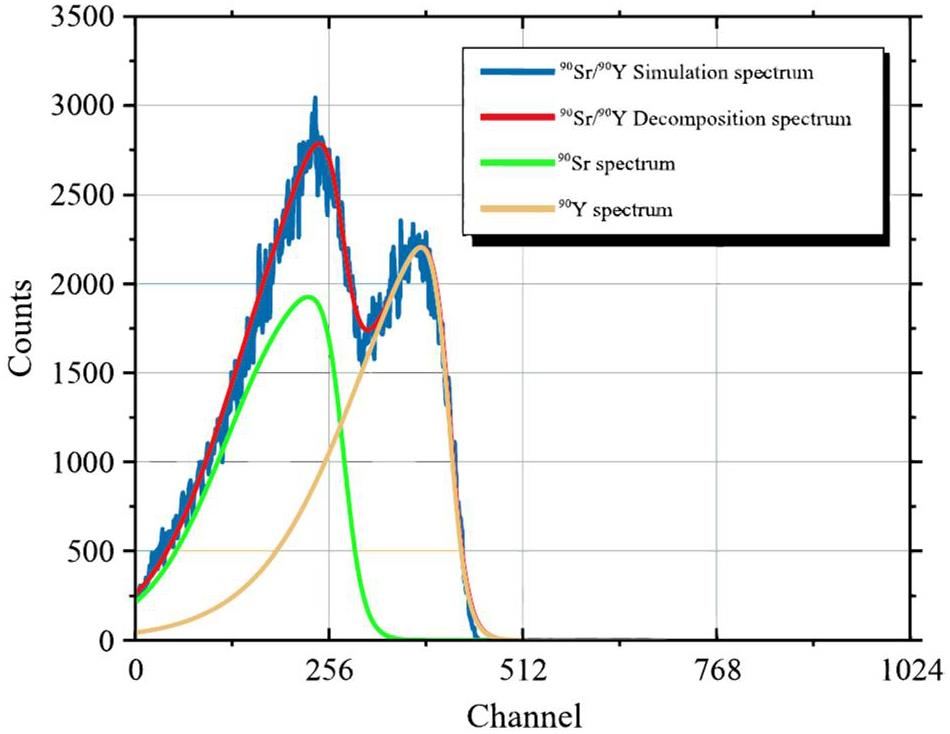
The analysis results of the Asym2Sig method show that the average count rate per minute for 90Y is 3154.871 CPM, which corresponds to 25.721%. The actual detection efficiency and activity of 90Y are 204.434 Bq with a relative error of 10.077% and 90Y, which corresponds to a simulated full-spectrum detection efficiency of 27.24% with an activity of 193.029 Bq and a relative error of 3.936%, which satisfied the testing expectations.
In summary, the logarithmic energy spectrum analysis results of the measured 90Sr/90Y sample source using the Asym2Sig and Fourier fitting interpolation methods show that 90Y activity errors analyzed by the two spectral-solving algorithms using the actual detection efficiency are both approximately 10%. When using the simulated full-spectrum detection efficiency, the errors are all within 5%, which is in line with experimental expectations. Moreover, the relative error of 90Y activity analyzed using the Asym2Sig method is smaller than that of the Fourier fitting interpolation method, indicating better analysis results. However, given the need to detect pure 90Y sample sources in advance, the analysis using the Asym2Sig method is more cumbersome than that using the Fourier fitting interpolation method. In the actual analysis process, the above two energy spectrum analysis methods can be selected based on the on-site experimental conditions.
Conclusion
This research is mainly devoted to the rapid analysis of β nuclides, including 14C, 90Sr, and 90Y, accumulated in the radioactive effluents of nuclear power plants as well as in the surrounding environment. Based on an in-depth understanding of the principle of the measurement and analysis of the logarithmic energy spectrum of β-nuclides, a hybrid β-energy spectrum analysis algorithm, i.e., the Fourier fitting interpolation method, is preliminarily designed and completed. The feasibility and validity of the Fourier fitting interpolation method are verified via two experiments. Firstly, the 14C/90Sr/90Y energy spectra simulated by GEANT4 are analyzed using Fourier fitting interpolation method, and 14C, 90Sr, and 90Y energy spectra obtained by Fourier fitting interpolation method are compared with the original simulated 14C, 90Sr, and 90Y energy spectra of GEANT4. The results showed that the analysis of 14C, 90Sr, and 90Y energy spectra obtained by Fourier fitting interpolation method is in good agreement with the simulated energy spectra of GEANT4. Second, the liquid scintillation measured data and GEANT4 simulated data of 90Sr/90Y sample sources were analyzed using the Fourier fitting interpolation method and Asym2Sig method, respectively. The results showed that when using Fourier fitting interpolation method, the average count rate per minute of 90Y was 3173.803 CPM, which corresponds to an activity of 205.66 Bq at a measured detection efficiency of 25.721% with a relative error of 10.737%. When using Asym2Sig method, the average count rate per minute of 90Y was 3154.871 CPM, which corresponds to an activity of 204.434 Bq at a measured detection efficiency of 25.721%, with a relative error of 10.077%. When the Asym2Sig method was used, the average count rate per minute of 90Y was 193.029 Bq at a simulated detection efficiency of 27.24%, with a relative error of 3.936%. Therefore, the activity error of 90Y analyzed using the actual detection efficiency of both algorithms was approximately 10%, and the error was within 5% when using the simulated full-spectrum detection efficiency, which is in line with the experimental expectations. Furthermore, the Asym2Sig method had a smaller relative error than the Fourier fitting interpolation method, indicating a better analysis performance. However, Asym2Sig method requires the prior detection of pure 90Y sample sources, making the analysis process more cumbersome than the Fourier fitting interpolation method. Two validation experiments demonstrated the superiority of the Fourier fitting interpolation method. This method not only avoids the cumbersome chemical separation process, but also reduces the harmful effects of chemical waste on the environment. In the future, we will continue to optimize the parameter settings and algorithmic flow of the Fourier fitting interpolation method to improve the accuracy and speed of β-nuclide energy spectra analysis. We introduce additional mathematical models and data processing techniques to address the challenges of applying the algorithm to complex environments such as noise interference and background radiation.
Operating margin for radioactive effluent released to the environment from Korean pressurized water reactors compared to the effluent control limits obtained by monitoring the concentration of radioactive effluent with radioactive effluent monitors
. Nucl. Sci. Tech. 56, 764-769 (2019). https://doi.org/10.1080/00223131.2019.1617205A history of high-power laser research and development in the United Kingdom
. High. Power. Laser. Sci. 9, 46-131 (2021). https://doi.org/10.1017/hpl.2021.5Analysis of a hybrid nuclear renewable energy resource in a distributed energy system for a rural area in Nigeria
. Energies 15, 7496 (2022). https://doi.org/10.3390/en15207496Discriminative measurement of absorbed dose rates in air from natural and artificial radionuclides in Namie Town
, Fukushima Prefecture. 18, 978 (2021). https://doi.org/10.3390/ijerph18030978The application of compulsory conciliation in the settlement of disputes over Fukushima contaminated water discharge
. Sci. Prog. 106, 4 (2023). https://doi.org/10.1177/00368504231191994Analysis of purification in radioactively contaminated ocean water near the Fukushima nuclear accident site
. Energy. Sci. Eng. 11, 3310-3316 (2023). https://doi.org/10.1002/ese3.1538Optimization method of burnable poison based on genetic algorithm and artificial neural network
. Annals of Nuclear Energy. At. Energy Sci. Technol. 55, 1456-1463 (2021). https://doi.org/10.7538/yzk.2020.youxian.0563Multiobjective genetic algorithm strategies for burnable poison design of pressurized water reactor
. Int. J. Energy Res. 45, 11930-11942 (2021). https://doi.org/10.1002/er.5926Development of Monte Carlo hybrid parallel algorithm and application in high resolution spatial-energy flux distribution calculation
. Elsevier B.V. 413,Application of the neutron-photon-electron coupling transport of cosRMC in fusion neutronics
. Elsevier B.V. 159,In situ beta‐gamma separation algorithm for cost‐effective assessment of radioactive waste resources
. Int. J. Energ. Res. 42, 4761-4769 (2018). https://doi.org/10.1002/er.4229Advances in nuclear detection and readout techniques
. Nucl. Sci. Tech. 34, 283-360 (2023). https://doi.org/10.1007/s41365-023-01359-0Gamma-, neutron-, and muon-induced environmental background simulations for 100Mo-based bolometric double-beta decay experiment at Jinping Underground Laboratory
. Nucl. Sci. Tech. 34, 54-61 (2023). https://doi.org/10.1007/s41365-023-01299-9A simplified fitting method for liquid scintillation spectra of mixed 90Sr/90Y at different quenching levels
. J. Nucl. Radiochem. 38, 364-370 (2016). https://doi.org/10.7538/hhx.2016.YX.2015041DECLAB: a software for liquid scintillation spectra deconvolution
. J. Radioanal. Nucl. Ch. 331, 3275-3282 (2022). https://doi.org/10.1007/s10967-022-08365-3Determining elemental strontium distribution in rat bones treated with strontium ranelate and strontium citrate using 2D micro-XRF and 3D dual energy K-edge subtraction synchrotron imaging
. Xray. Spectrom. 49, 424-433 (2020). https://doi.org/10.1002/xrs.3127On the mechanisms of formation of excited yttrium atoms under ion bombardment of yttrium and yttrium-aluminum garnet
. Vacuum 129, 148-152 (2016). https://doi.org/10.1016/j.vacuum.2016.03.014γW box inside out: nuclear polarizabilities distort the beta decay spectrum
. Phys. Rev. Lett. 123,AutoCal: a method for automatic energy calibration of β–γ systems based on a 137Cs spectrum
. J. Radioanal. Nucl. Chem. 296, 465-469 (2013). https://doi.org/10.1007/s10967-012-2100-8Standardization of tritium water by TDCR method
. Plasma. Sci. Technol. 14, 644-646 (2012). https://doi.org/10.1088/1009-0630/14/7/17Data-Weighted least square progressive and iterative approximation and related B-Spline curve fitting
. Comput. Aided. Des. 31, 1574-1580 (2019). https://doi.org/10.3724/SP.J.1089.2019.17585A ROOT-based detector test system
. Nucl. Sci. Tech. 32, 115 (2021). https://doi.org/10.1007/s41365-021-00952-5An experimental review of open heavy flavor and quarkonium production at RHIC
. Nucl. Sci. Tech. 31, 81 (2020). https://doi.org/10.1007/s41365-020-00785-8Perturbation analysis and condition numbers of mixed least squares-scaled total least squares problem
. Numer. Algor. 89, 1223-1246 (2022). https://doi.org/10.1007/s11075-021-01151-4Study on the applicability of total least squares method in surveying adjustment
. Geod. Geodyn. 34, 121-124 (2014). https://doi.org/10.14075/j.jgg.2014.03.015Alignment based kernel learning with a continuous set of base kernels
. Mach. Learn. 91, 305-324 (2013). https://doi.org/10.1007/s10994-013-5361-8Influence function and robust variant of kernel canonical correlation analysis
. Neural. Comput. 304, 0925-2312 (2018). https://doi.org/10.1016/j.neucom.2018.04.008Approximation of p-Biharmonic problem using WEB-Spline based Mesh-Free method
. Int. J. Nonlin. Sci. Num. 20, 703-712 (2019). https://doi.org/10.1515/ijnsns-2018-0298Quintic spline method for solving Linear and nonlinear boundary value problems
. Sains. Malays. 45, 1007-1012 (2016). https://api.semanticscholar.org/CorpusID:28026763Divergent triangular sums of double trigonometric Fourie series
. J. Contemp. Mathemat. Anal. 50, 196-207 (2015). https://doi.org/10.3103/S1068362315040056Robust ellipse fitting based on sparse combination of data points
. Ieee. T. Image. Process. 22, 2207-2218 (2013). https://doi.org/10.1109/TIP.2013.2246518.Median robust nonlinear weighted total least squares estimator of nonlinear EIV models: three algorithms
. Surv. Rev. 55, 1-17 (2022). https://doi.org/10.1080/00396265.2022.2127605Integro spline quasi-interpolants and their super convergence
. Comp. Appl. Math. 39, 239 (2020). https://doi.org/10.1007/s40314-020-01286-5A numerical method for the solutions to nonlinear dynamic systems based on cubic spline interpolation functions
. Appl. Math. Mech. 36, 887-896 (2014). https://doi.org/10.3879/j.issn.1000-0887.2015.08.010A fractal model for constrained curve and surface interpolation
. Eur. Phys. J. Spec. Top. 232, 1015-1025 (2023). https://doi.org/10.1140/epjs/s11734-023-00862-0Fine power reconfiguration calculation of marine reactor core
. At. Energy. Sci. Technol. 44, 307-311 (2010). https://doi.org/CNKI:SUN:YZJS.0.2010-S1-063Development and preliminary verification of flux map processing software MAPLE
. At. Energy. Sci. Technol. 47, 430-432 (2013). https://doi.org/10.7538/yzk.2013.47.S1.0430Application of cubic splines on bakhvalov meshes in the case of a boundary layer
. Comput. Math. and Math. Phys. 61, 1911-1930 (2021). https://doi.org/10.1134/S096554252112006XCubic spline interpolation with optimal end conditions
. J. Comput. Appl. Math. 425, 377-427 (2023). https://doi.org/10.1016/j.cam.2022.115039The authors declare that they have no competing interests.


